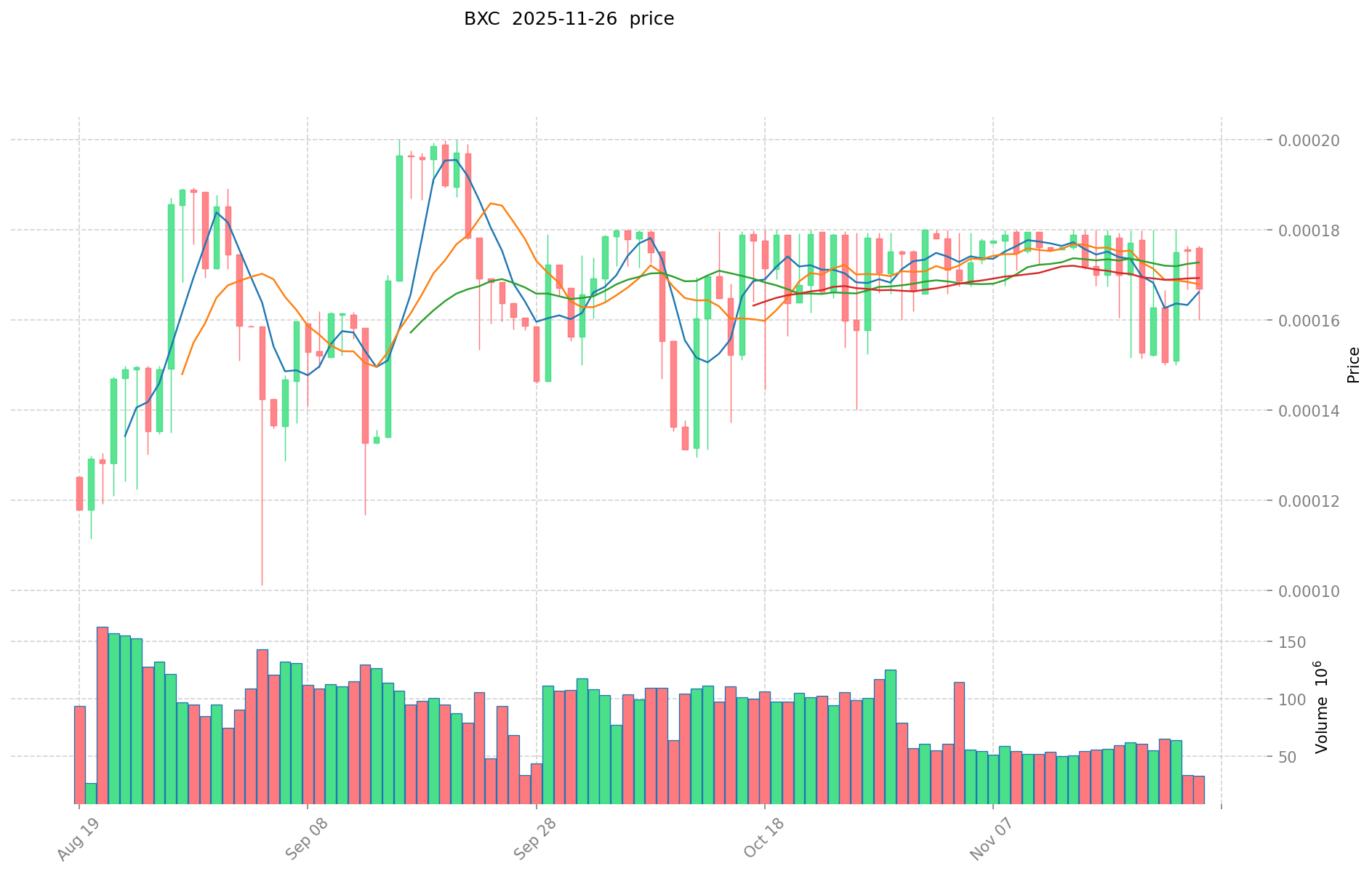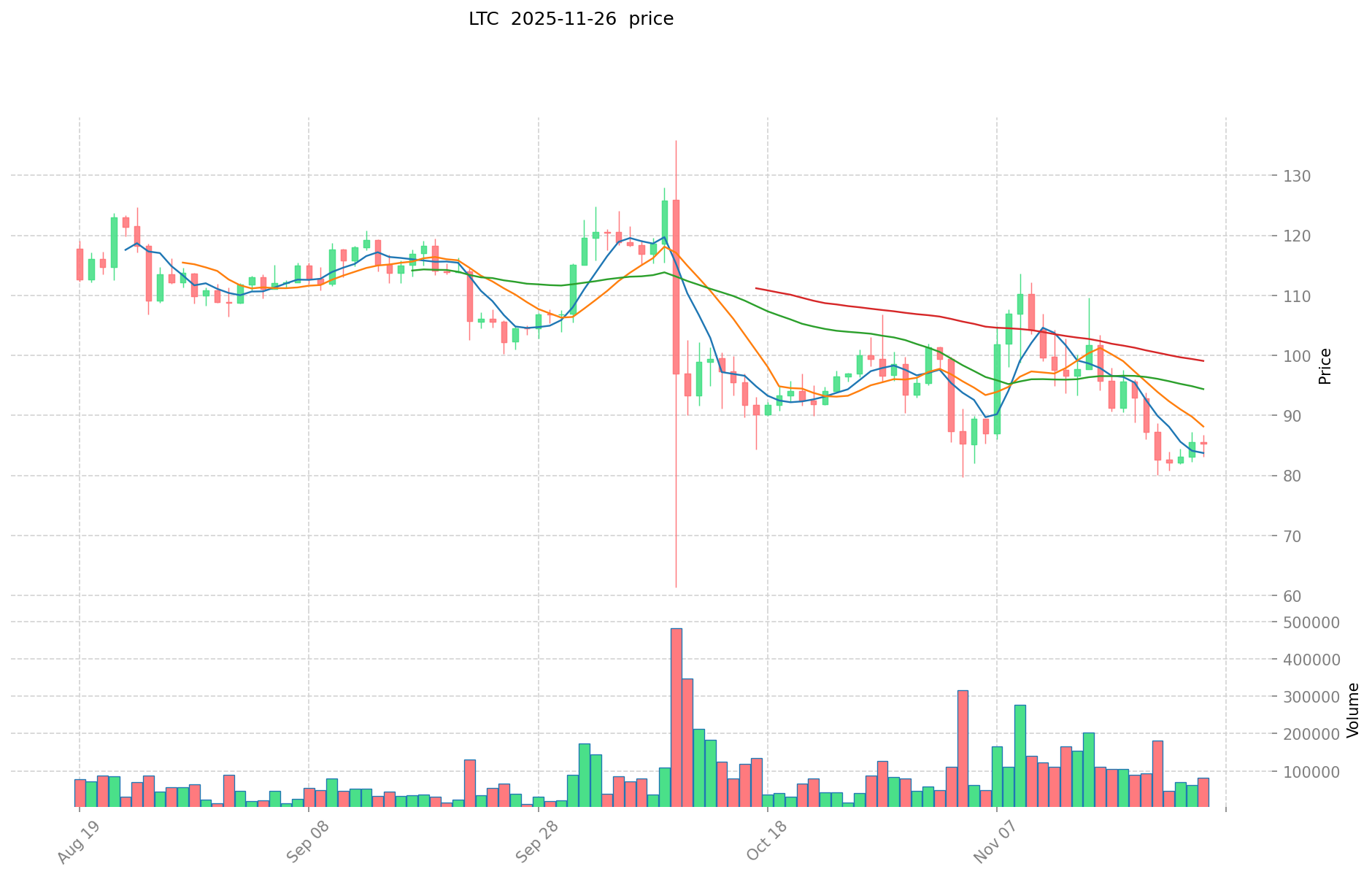BXC vs LTC: Comparing Two Cryptocurrencies for Investment Potential
Introduction: BXC vs LTC Investment Comparison
In the cryptocurrency market, BonusCloud vs Litecoin comparison has always been a topic that investors can't avoid. The two not only have significant differences in market cap ranking, application scenarios, and price performance, but also represent different positioning of crypto assets.
BonusCloud (BXC): Since its launch, it has gained market recognition for its focus on decentralized infrastructure combining blockchain and cloud computing.
Litecoin (LTC): Since 2011, it has been hailed as the "silver to Bitcoin's gold" and is one of the cryptocurrencies with the highest global trading volume and market capitalization.
This article will comprehensively analyze the investment value comparison between BonusCloud and Litecoin, focusing on historical price trends, supply mechanisms, institutional adoption, technological ecosystems, and future predictions, and attempt to answer the question most concerning investors:
"Which is the better buy right now?"
I. Price History Comparison and Current Market Status
BXC (Coin A) and LTC (Coin B) Historical Price Trends
- 2021: BXC reached its all-time high of $0.0041906 on May 13, 2021.
- 2021: LTC hit its all-time high of $410.26 on May 10, 2021, during the broader cryptocurrency bull market.
- Comparative analysis: In the market cycle since their all-time highs, BXC has dropped from $0.0041906 to $0.0001619, while LTC has declined from $410.26 to $86.22.
Current Market Situation (2025-11-27)
- BXC current price: $0.0001619
- LTC current price: $86.22
- 24-hour trading volume: BXC $11,767.18 vs LTC $3,734,102.46
- Market Sentiment Index (Fear & Greed Index): 20 (Extreme Fear)
Click to view real-time prices:
- Check BXC current price Market Price
- Check LTC current price Market Price


II. Core Factors Affecting BXC vs LTC Investment Value
Supply Mechanism Comparison (Tokenomics)
- BXC: Limited supply of 2.1 billion tokens, with 50% allocated to pre-sale and 50% to partnerships and ecosystem growth
- LTC: Fixed supply cap of 84 million coins with halving mechanism approximately every 4 years
- 📌 Historical Pattern: Limited supply cryptocurrencies like LTC have historically shown cyclical price movements around halving events, while newer tokens like BXC have yet to establish long-term supply-based price patterns.
Institutional Adoption and Market Applications
- Institutional Holdings: LTC has more established institutional presence, being listed on major exchanges since 2013 and available through traditional financial products
- Enterprise Adoption: LTC has wider payment infrastructure integration and merchant adoption, while BXC focuses on cross-chain applications and DeFi ecosystem development
- National Policies: LTC benefits from broader regulatory clarity as an established cryptocurrency, while BXC faces typical regulatory uncertainty of newer blockchain projects
Technical Development and Ecosystem Building
- BXC Technical Features: Cross-chain interoperability focus, staking capabilities, and ecosystem designed for DeFi applications
- LTC Technical Development: MimbleWimble Extension Blocks (MWEB) implementation for enhanced privacy and scalability, with continued development as a payment-focused blockchain
- Ecosystem Comparison: LTC has stronger payment infrastructure and merchant adoption, while BXC is positioning itself in the DeFi, cross-chain liquidity, and staking sectors
Macroeconomic Factors and Market Cycles
- Performance During Inflation: LTC has longer track record as potential inflation hedge, often correlated with Bitcoin's movements during inflationary periods
- Macroeconomic Monetary Policy: Both coins typically show sensitivity to Federal Reserve decisions and broader crypto market trends
- Geopolitical Factors: LTC's established network offers reliability for cross-border transactions, while BXC's cross-chain capabilities could potentially address emerging international transaction needs
III. 2025-2030 Price Prediction: BXC vs LTC
Short-term Prediction (2025)
- BXC: Conservative $0.000139234 - $0.0001619 | Optimistic $0.0001619 - $0.000205613
- LTC: Conservative $46.8504 - $86.76 | Optimistic $86.76 - $108.45
Mid-term Prediction (2027)
- BXC may enter a growth phase, with projected prices ranging from $0.0001710773015 to $0.000240858832375
- LTC may enter a bullish market, with projected prices ranging from $80.15810625 to $158.178663
- Key drivers: Institutional fund inflows, ETF, ecosystem development
Long-term Prediction (2030)
- BXC: Base scenario $0.000274452624773 - $0.000291970877418 | Optimistic scenario $0.000291970877418 - $0.00037664243187
- LTC: Base scenario $87.018460217676 - $142.6532134716 | Optimistic scenario $142.6532134716 - $146.932809875748
Disclaimer: The above predictions are based on historical data and market analysis. Cryptocurrency markets are highly volatile and subject to rapid changes. These projections should not be considered as financial advice. Always conduct your own research before making investment decisions.
BXC:
| 年份 | 预测最高价 | 预测平均价格 | 预测最低价 | 涨跌幅 |
|---|---|---|---|---|
| 2025 | 0.000205613 | 0.0001619 | 0.000139234 | 0 |
| 2026 | 0.000266446925 | 0.0001837565 | 0.00009555338 | 13 |
| 2027 | 0.000240858832375 | 0.0002251017125 | 0.0001710773015 | 39 |
| 2028 | 0.000328502184136 | 0.000232980272437 | 0.000193373626123 | 43 |
| 2029 | 0.00030320052655 | 0.000280741228287 | 0.000244244868609 | 73 |
| 2030 | 0.00037664243187 | 0.000291970877418 | 0.000274452624773 | 80 |
LTC:
| 年份 | 预测最高价 | 预测平均价格 | 预测最低价 | 涨跌幅 |
|---|---|---|---|---|
| 2025 | 108.45 | 86.76 | 46.8504 | 0 |
| 2026 | 116.14995 | 97.605 | 54.6588 | 13 |
| 2027 | 158.178663 | 106.877475 | 80.15810625 | 23 |
| 2028 | 143.13031452 | 132.528069 | 92.7696483 | 53 |
| 2029 | 147.4772351832 | 137.82919176 | 122.6679806664 | 59 |
| 2030 | 146.932809875748 | 142.6532134716 | 87.018460217676 | 65 |
IV. Investment Strategy Comparison: BXC vs LTC
Long-term vs Short-term Investment Strategies
- BXC: Suitable for investors focused on DeFi ecosystem potential and cross-chain applications
- LTC: Suitable for investors seeking stability and potential inflation hedge properties
Risk Management and Asset Allocation
- Conservative investors: BXC: 10% vs LTC: 90%
- Aggressive investors: BXC: 30% vs LTC: 70%
- Hedging tools: Stablecoin allocation, options, cross-currency portfolios
V. Potential Risk Comparison
Market Risk
- BXC: Higher volatility due to lower market cap and trading volume
- LTC: Susceptible to broader crypto market trends and Bitcoin price movements
Technical Risk
- BXC: Scalability, network stability
- LTC: Mining centralization, potential security vulnerabilities
Regulatory Risk
- Global regulatory policies may have differing impacts on both assets
VI. Conclusion: Which Is the Better Buy?
📌 Investment Value Summary:
- BXC advantages: Focus on cross-chain interoperability, DeFi ecosystem development
- LTC advantages: Established history, wider adoption, proven track record
✅ Investment Advice:
- New investors: Consider a higher allocation to LTC for stability
- Experienced investors: Balanced portfolio with both LTC and BXC
- Institutional investors: LTC for larger allocations, BXC for diversification
⚠️ Risk Warning: Cryptocurrency markets are highly volatile. This article does not constitute investment advice. None
VII. FAQ
Q1: What are the main differences between BXC and LTC? A: BXC focuses on decentralized infrastructure combining blockchain and cloud computing, while LTC is known as "silver to Bitcoin's gold" and has a longer history in the cryptocurrency market. BXC has a limited supply of 2.1 billion tokens, while LTC has a fixed supply cap of 84 million coins with a halving mechanism.
Q2: Which coin has shown better price performance historically? A: LTC has shown better historical price performance, reaching an all-time high of $410.26 in May 2021, compared to BXC's all-time high of $0.0041906 in the same month. LTC also has a higher current price and trading volume.
Q3: How do the supply mechanisms of BXC and LTC differ? A: BXC has a limited supply of 2.1 billion tokens, with 50% allocated to pre-sale and 50% to partnerships and ecosystem growth. LTC has a fixed supply cap of 84 million coins with a halving mechanism approximately every 4 years.
Q4: What are the key factors affecting the investment value of BXC and LTC? A: Key factors include supply mechanisms, institutional adoption, market applications, technical development, ecosystem building, and macroeconomic factors such as inflation and monetary policy.
Q5: What are the long-term price predictions for BXC and LTC? A: By 2030, BXC is predicted to reach $0.000274452624773 - $0.00037664243187, while LTC is predicted to reach $87.018460217676 - $146.932809875748. However, these predictions are subject to market volatility and should not be considered financial advice.
Q6: How do the investment strategies for BXC and LTC differ? A: BXC is more suitable for investors focused on DeFi ecosystem potential and cross-chain applications, while LTC is better for those seeking stability and potential inflation hedge properties. Conservative investors might allocate 10% to BXC and 90% to LTC, while aggressive investors might opt for 30% BXC and 70% LTC.
Q7: What are the main risks associated with investing in BXC and LTC? A: Both coins face market risks, technical risks, and regulatory risks. BXC has higher volatility due to its lower market cap and trading volume, while LTC is susceptible to broader crypto market trends and Bitcoin price movements. Technical risks include scalability and network stability for BXC, and mining centralization for LTC.
Share
Content